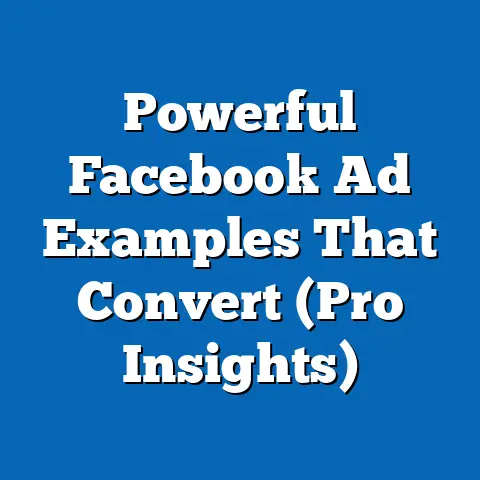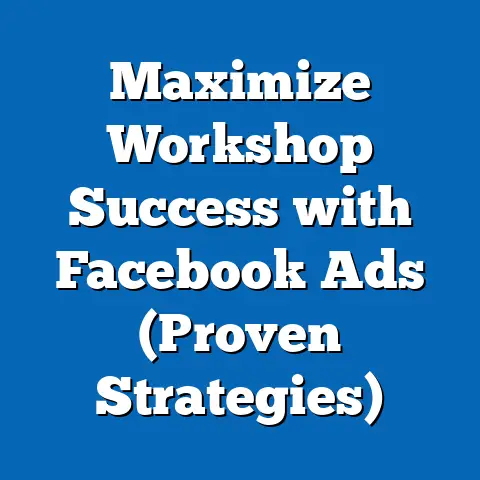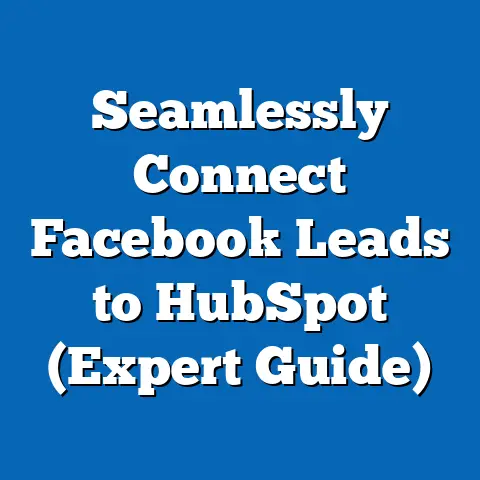Elevate Facebook Ads Account Quality (Expert Strategies)
Elevate Facebook Ads Account Quality: Expert Strategies for Success
Facebook Ads, in today’s digital marketing arena, are not just a tool but a necessity. In regions like North America, where digital marketing is highly competitive and consumer behavior is significantly influenced by online trends, the quality of a Facebook Ads account can make or break a business’s marketing efforts. North American consumers are savvy, bombarded with ads daily, and quick to dismiss anything that doesn’t immediately grab their attention or feel relevant. This makes maintaining a high-quality Facebook Ads account—one that delivers engaging, targeted, and compliant content—absolutely critical.
Account quality isn’t merely a vanity metric; it’s a direct reflection of how well your ads resonate with your target audience and how effectively you’re using Facebook’s advertising platform. A high-quality account can lead to increased ad reach, lower costs per click, and ultimately, better campaign performance. In contrast, a low-quality account can result in limited reach, higher ad costs, and diminished returns on investment. Therefore, understanding and improving Facebook Ads account quality is essential for any business looking to thrive in the North American digital market.
So, what exactly does it mean to have a high-quality Facebook Ads account, and how can you achieve it? Let’s break it down.
Understanding Facebook Ads Account Quality
Facebook Ads account quality is essentially a measure of how well your ads and overall account performance align with Facebook’s standards and user expectations. Think of it as Facebook’s way of ensuring that ads are relevant, engaging, and don’t violate their policies.
Key Metrics of Account Quality
- Ad Relevance Score: This score indicates how relevant your ad is to the audience you’re targeting. A higher relevance score typically leads to lower costs and better ad delivery.
- Engagement Rates: High engagement rates (likes, comments, shares) signal that your ads are resonating with your audience, positively impacting your account quality.
- Conversion Rates: The percentage of users who take a desired action (e.g., purchase, sign-up) after seeing your ad. Higher conversion rates indicate that your ads are effective and relevant.
- Feedback Scores: Negative feedback (e.g., users hiding your ad) can significantly lower your account quality.
The Implications of Low Account Quality
Trust me, I’ve seen the repercussions of neglecting account quality. A low score can lead to:
- Reduced Ad Reach: Facebook may limit the number of people who see your ads.
- Higher Costs: You’ll pay more for each click or impression.
- Poor Campaign Performance: Ultimately, your campaigns will fail to deliver the desired results.
How Facebook Evaluates Account Quality
Facebook’s algorithm considers various factors when evaluating account quality, including:
- Ad Performance: Historical data on how your ads have performed in terms of engagement, conversions, and feedback.
- Ad Content: Whether your ad content is relevant, engaging, and complies with Facebook’s policies.
- Landing Page Experience: The quality and relevance of the landing page your ad directs users to.
- User Feedback: Both positive and negative feedback from users who have seen your ads.
Key Takeaway: Understanding the metrics and factors that contribute to Facebook Ads account quality is the first step towards improving it. Now, let’s move on to the expert strategies that can help you elevate your account.
Expert Strategy #1 – Audience Segmentation
Audience segmentation is, in my opinion, one of the most critical aspects of improving your Facebook Ads account quality. It’s all about dividing your target audience into smaller, more specific groups based on shared characteristics. The more precisely you can target your ads, the more relevant they’ll be, leading to higher engagement and better performance.
Why Audience Segmentation Matters
Think of it this way: would you show the same ad for running shoes to a marathon runner and someone who’s never exercised? Of course not! Audience segmentation allows you to tailor your messaging and creative to specific groups, increasing the likelihood that they’ll find your ads relevant and engaging.
Actionable Steps for Effective Segmentation
- Demographic Segmentation: This involves segmenting your audience based on factors like age, gender, location, education, and income. For example, if you’re selling luxury skincare products, you might target women aged 35-55 with a higher income level.
- Psychographic Segmentation: This goes beyond demographics and focuses on your audience’s values, interests, lifestyle, and personality. Understanding their motivations and aspirations can help you craft more compelling ad copy.
- Behavioral Segmentation: This involves segmenting your audience based on their past behavior, such as purchase history, website activity, and engagement with your brand. Facebook’s pixel can be incredibly helpful for tracking this data.
Example: Imagine you’re a clothing retailer in North America. You could segment your audience as follows:
- Segment 1: Young adults (18-25) interested in fast fashion and social media trends.
- Segment 2: Working professionals (26-40) looking for stylish and comfortable workwear.
- Segment 3: Parents (30-45) seeking durable and affordable clothing for their children.
By creating separate ad campaigns tailored to each of these segments, you can ensure that your ads are highly relevant and engaging.
Success Stories from North America
I’ve seen numerous brands in North America successfully utilize audience segmentation to boost their ad performance. For instance, a local coffee shop segmented its audience based on their coffee preferences (e.g., espresso lovers, iced coffee drinkers) and created targeted ads promoting specific drinks. This resulted in a significant increase in foot traffic and sales.
Key Takeaway: Audience segmentation is a powerful tool for improving your Facebook Ads account quality. By understanding your audience and tailoring your ads to their specific needs and interests, you can increase engagement, lower costs, and drive better results.
Expert Strategy #2 – Ad Creative Optimization
Ad creative optimization is all about crafting visually appealing and compelling ads that grab your audience’s attention and drive them to take action. It’s not enough to simply have a great product or service; you need to present it in a way that resonates with your target audience.
The Role of Compelling Ad Creatives
Think about the ads that have caught your eye while scrolling through Facebook. What made them stand out? Chances are, it was a combination of engaging visuals, compelling copy, and a clear call to action. High-quality ad creatives can significantly boost your account quality by increasing engagement rates and driving conversions.
Best Practices for Creating Engaging Visuals and Copy
- High-Quality Visuals: Use professional-quality images or videos that are visually appealing and relevant to your product or service. Avoid using stock photos that look generic or staged.
- Compelling Copy: Write clear, concise, and persuasive ad copy that highlights the benefits of your product or service. Use strong verbs and avoid jargon.
- Clear Call to Action: Tell your audience exactly what you want them to do (e.g., “Shop Now,” “Learn More,” “Sign Up”). Make your call to action prominent and easy to click.
- Mobile-First Design: Remember that most Facebook users access the platform on their mobile devices. Ensure that your ad creatives are optimized for mobile viewing.
A/B Testing Ad Creatives
A/B testing involves creating multiple versions of your ad creatives and testing them against each other to see which performs best. This is a crucial step in ad creative optimization.
How to A/B Test:
- Identify Variables: Decide which elements of your ad creative you want to test (e.g., headline, image, call to action).
- Create Variations: Create multiple versions of your ad with different variations of the chosen elements.
- Run Tests: Run your ads and track their performance.
- Analyze Results: Analyze the data to determine which variations performed best.
- Refine Campaigns: Use the insights from your A/B tests to refine your ad creatives and improve your overall campaign performance.
Example: A clothing retailer in North America might A/B test different images of their new fall collection to see which resonates best with their target audience. They could also test different headlines to see which drives the most clicks.
Case Studies from North America
I’ve seen numerous businesses in North America successfully optimize their ad creatives through A/B testing. For example, a local restaurant tested different images of their menu items and found that photos of their most popular dishes generated the highest engagement and sales.
Key Takeaway: Ad creative optimization is an ongoing process that requires experimentation and analysis. By following best practices, A/B testing your creatives, and analyzing your results, you can create ads that resonate with your audience, boost your account quality, and drive better results.
Expert Strategy #3 – Data-Driven Decision Making
Data is your best friend when it comes to Facebook Ads. Leveraging data analytics to inform your ad strategies is essential for improving your account quality and maximizing your ROI.
The Importance of Data Analytics
Without data, you’re essentially flying blind. Data analytics provides valuable insights into your audience, ad performance, and overall campaign effectiveness. By tracking and analyzing key metrics, you can identify what’s working, what’s not, and make informed decisions to optimize your campaigns.
Tools and Metrics for Tracking Performance
- Facebook Ads Manager: This is your primary tool for tracking ad performance. It provides a wealth of data on metrics like impressions, clicks, reach, frequency, cost per click, and conversion rates.
- Facebook Pixel: The Facebook Pixel is a piece of code that you install on your website to track user behavior. It allows you to track conversions, retarget website visitors, and optimize your ads for specific actions.
- Google Analytics: While not directly related to Facebook Ads, Google Analytics can provide valuable insights into how users behave on your website after clicking on your ads.
Key Metrics to Track:
- Click-Through Rate (CTR): The percentage of users who click on your ad after seeing it.
- Cost Per Click (CPC): The amount you pay for each click on your ad.
- Conversion Rate: The percentage of users who take a desired action after clicking on your ad.
- Return on Ad Spend (ROAS): The amount of revenue you generate for every dollar you spend on ads.
Examples from North America
I’ve seen businesses in North America effectively utilize data to make informed decisions that elevated their account quality. For example, an e-commerce store tracked the performance of their different ad campaigns and discovered that ads targeting mobile users were generating significantly higher conversion rates. They then shifted their budget towards mobile ads, resulting in a substantial increase in sales.
Key Takeaway: Data-driven decision-making is essential for optimizing your Facebook Ads campaigns and improving your account quality. By tracking and analyzing key metrics, you can identify what’s working, what’s not, and make informed decisions to maximize your ROI.
Expert Strategy #4 – Compliance with Facebook Policies
Adhering to Facebook’s advertising policies is absolutely crucial for maintaining your account quality. Violating these policies can result in ad disapprovals, account restrictions, or even permanent account suspension.
The Significance of Compliance
Facebook’s advertising policies are designed to protect users from misleading, offensive, or harmful content. By complying with these policies, you not only avoid penalties but also build trust with your audience.
Common Pitfalls to Avoid
- Misleading Claims: Avoid making false or exaggerated claims about your product or service.
- Offensive Content: Do not promote content that is discriminatory, hateful, or violent.
- Prohibited Products: Be aware of Facebook’s list of prohibited products and services (e.g., tobacco, firearms).
- Copyright Infringement: Do not use copyrighted images or videos without permission.
Tips for Staying Updated
Facebook’s advertising policies are constantly evolving. It’s essential to stay updated with the latest changes to ensure that your ads remain compliant.
- Review Facebook’s Advertising Policies Regularly: Familiarize yourself with the latest version of Facebook’s advertising policies.
- Subscribe to Facebook’s Advertising Updates: Stay informed about policy changes and updates by subscribing to Facebook’s advertising newsletters or following their official blog.
- Consult with a Facebook Advertising Expert: If you’re unsure about whether your ads comply with Facebook’s policies, consider consulting with a Facebook advertising expert.
Examples from North America
I’ve seen businesses in North America successfully navigate Facebook’s advertising policies by staying informed and seeking expert advice. For example, a local health clinic consulted with a Facebook advertising expert to ensure that their ads promoting medical services complied with all applicable regulations.
Key Takeaway: Compliance with Facebook’s advertising policies is essential for maintaining your account quality and avoiding penalties. By staying informed, avoiding common pitfalls, and seeking expert advice when needed, you can ensure that your ads remain compliant and your account stays in good standing.
Conclusion
Maintaining a high-quality Facebook Ads account is critical for sustainable success in today’s competitive digital marketing landscape, especially in regions like North America where consumers are discerning and ad saturation is high. By focusing on audience segmentation, ad creative optimization, data-driven decision-making, and compliance with Facebook’s advertising policies, you can elevate your account quality, improve your ad performance, and maximize your ROI.
Remember, Facebook Ads is not a “set it and forget it” platform. It requires continuous monitoring, testing, and optimization. By implementing these expert strategies, you can stay ahead of the curve and achieve sustainable success in the world of Facebook advertising.
Call to Action
Now it’s your turn! Share your own experiences with Facebook Ads account quality in the comments below. What strategies have you found most effective? What challenges have you faced? Let’s learn from each other and continue to elevate our Facebook advertising efforts.
Also, don’t forget to share this article with your network and explore the additional resources provided below to further enhance your Facebook advertising knowledge.
Additional Resources
- Facebook Advertising Policies: [Link to Facebook’s Advertising Policies]
- Facebook Ads Manager Help Center: [Link to Facebook Ads Manager Help Center]
- Facebook Business Blog: [Link to Facebook Business Blog]






